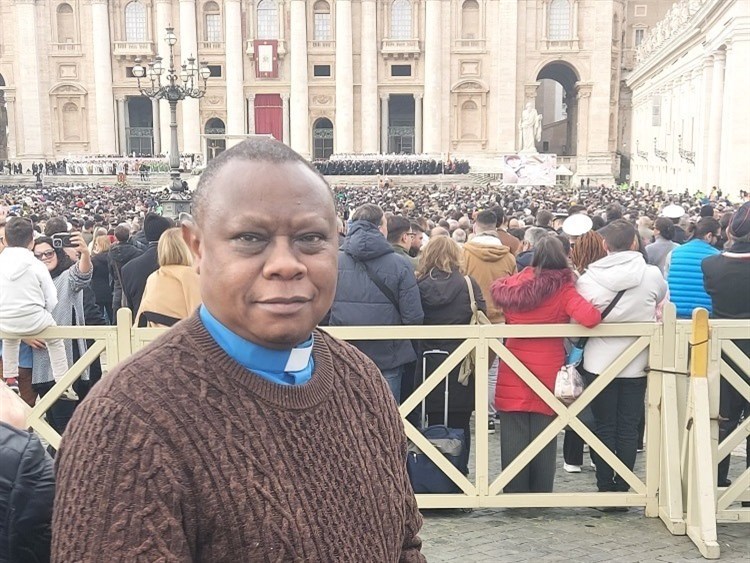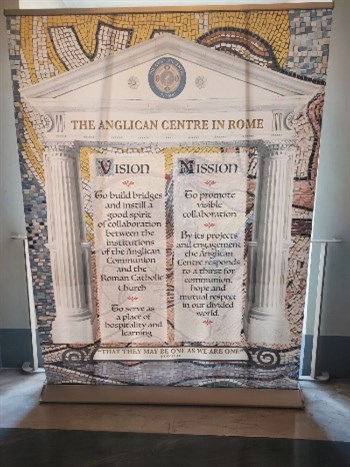 Experiencing Ecumenical Dialogue in Rome
Experiencing Ecumenical Dialogue in Rome
Rev John Madinda from the Long Stratton and Pilgrim Team Ministry took a recent sabbatical in Rome with a focus on Christian unity: he reports on his experience and the delight he felt to be in ecumenical fellowship
Early in March this year, I had an opportunity of taking a sabbatical leave, of which some of the time was spent in Rome and the Anglican Centre. I intended to find out ways in which the Bible is used in making key decisions in the Anglican Church, bearing in mind that, there are 4 sources of authority in guiding our discernment process in the Anglican Church. They run in the following order: The Bible, Reason, Tradition, and Experience.
The idea is that any decision - particularly one which is contentious - needs a backing from what the Bible says, then of course it has to be backed by reason, then tradition and finally experience, if need be, since experience is seen to be the most subjective of the four. By choosing that topic, I thought the best way of going about it, was to compare with another denomination, so I chose to look at the Roman Catholic Church which has a slightly different approach yet shares a common background.
It was lovely to be based at the Anglican Centre in the heart of the city of Rome, 15 minutes’ walk from the Colosseum, half an hour walk from The Vatican. The centre is rigorous in its ecumenical efforts, above the background of the Anglo - Roman church relations, and is well situated and resourced. Its aim is to foster progressive relationships and expressions of faith in the two traditions going back to 1966, when Archbishop Michael Ramsey of Canterbury and Pope John Paul VI met in Rome in a historical move to bring the two churches to work together. This move was inspired by the command of Jesus in His prayer we find in John 17:21, “That they all may be one.” And since that meeting of the two leaders, the initiative has been explored by the two communions to see what that unity aspired by Jesus towards the church, should look like in praxis. This move lifted the deadlock and a frozen relationship which surrounded the 2 communions since the 16th Century.
The staff at the Anglican Centre led by the director was very welcoming and made me feel at home and comfortable. Each Tuesday, there was an ecumenical Eucharistic service followed by a community lunch involving expats, academics and clergy from the various denominations within Rome. In the 2 Sundays I spent in Rome, I attended a Holy Communion service in English at the All Saints Anglican Church on the first Sunday. Following that service, I went to attend an outdoor Mass in Latin at St Peter’s Square, in which Pope Francis gave a homily. The following Sunday, I attended a Catholic Church Eucharistic service in English which was quite international, with a visiting choir of High School students from America.
At the centre, there was endless material to go through, but with a resourceful person there, I was directed straight to the material I needed and even more important, I was directed to the latest material coming from various stages of dialogue and efforts towards Ecumenical Koinonia, which made it significantly quicker to get what I needed. My experience of the ongoing dialogue was like travelling along the main river with lots of tributaries coming in and joining the main river, while observing the changes of scene.
There were 2 main strands on the dialogue process:
-
Roman Catholic and Anglican led process (At the Anglican Centre in Rome)
This process of dialogue began by the Common Declaration for Dialogue, kick-started by the meeting between Pope John Paul VI and Archbishop Michael Ramsey in 1966. This evolved into becoming the Anglican Roman Catholic International Commission (ARCIC) Phase I, II and III. In this process of dialogue, other commissions have been charged with the responsibility to carry forward the ongoing consultation, such as the International Anglican Roman Catholic Commission on Unity and Mission (IARCCUM) and the more recent Inter-Anglican Standing Commission on Unity Faith and Order, (IASCUFO) all focusing on the various matters which relate to issues which may be considered as internal, akin things from inside each communion.
-
Mutual Accountability Desk for Ecumenism (At Centro Pro Unione)
This is an initiative driven by the Roman Catholic Church, promoting the process of Synodality in identifying and resolving issues prominent to the church. This is coordinated through the newly formed centre in Rome - the “Centro Pro Unione”. This was very interesting that although it seems to be a Roman Catholic driven initiative, yet it’s perspective is more focused on Ecumenism and Koinonia, by promoting a better way to inform the church and help it in facing its challenges and seeking ways in which these can be effectively addressed.
It is also important to note that, while we recognise this process between the Anglican Church and the Roman Catholic Church, there has also been efforts made between the Lutheran Church and the Roman Catholic Church, resulting in the agreement on matters of Theology and Mission, which produced the “Joint Declaration on the Doctrine of Justification” (JDDJ) in 1999, to which other denominations such as Anglicans, Methodists and Reformed have joined.
Unity in diversity - We read in Jesus’ prayer saying, “That they may be one just as I am one with you”. [John 17:21] This has been a mantra of inspiration to the ecumenical movement, bringing together churches from all traditions. This unity comes under the core which has remained essentially based on God’s sovereignty, and His saving grace through Christ. This saving grace not only unites God and humanity but more significantly unites all humanity from every tribe, languages and nations under the Lordship of Christ. It is this unity to which Christ prayed for, when he said, “I pray that they may be one.” Christ as omniscient would have foreseen the challenges which the church was to face to test and to sieve it, as it happened through the schisms. If we see this as part of the outworking of the Holy Spirit, contesting with the human condition to drive forward the divine mandate of taking the Gospel to the ends of the earth, we can see the various expressions of church and tradition as complementary by expressing its rich diversity. We need to remember that even when Jesus chose his first disciples, he picked a diverse group. In the book titled “Men with a Message: An introduction to the New Testament and its writers” by Steve Motyer and John Stott, the point they make is to, “discover the distinctiveness of the New Testament authors such as Paul, James, and Peter and how even in their individuality a unified message comes through. Churches together give us such an expression of what the church is, diverse and distinctive but with one message. It is this diversity that has made the church unique, and there is no better way that the Apostle Paul could define it than by using the metaphor of the body of Christ, and its unity as expressed through the Eucharist.
Sharing and Partnership - Considering the diversity of the church in its tradition and expressions, part of the ecumenical process involves sharing and partnership. This can be seen a tool for dialogue to promote mutual understanding and leaning from each other, but also to know the width, breadth, depth and height of the Gospel message we proclaim and represent.
It is within such perspective, I found the role of the Anglican Centre in Rome, an essential place and a gift from God, established to express and facilitate that ecumenical unity. Its location and resources are very convenient and relevant to its purpose.
Finally, It was a breath-taking experience to visit countless churches and landmarks going back to more than 2000 years ago but still standing strong. I was amazed at the Vatican Museum and the Sistine Chapel, not knowing that in less than three months following our visit, the Conclave would gather in that room to elect a new Pope and Bishop of Rome. We also attended a midweek service in St Mary Maggiore also not knowing that in less than three months His Holiness Pope Francis would be laid to rest in that same building.
Combining the events of the gathering of the Conclave followed by the funeral, displayed the great spirit of Ecumenism and Koinonia, when we saw people from all backgrounds, denominations, ranks and churchmanship gathered at St Peter’s Basilica, to pay their respect and commend His Holiness to his eternal rest.
While I was there, although my focus was on the Roman Catholic Anglican relations, I was greatly encouraged in seeing other undergirding currents which involved intentional efforts of Koinonia with other denominations.

Rev John Madinda is the Team Vicar for a group of 6 rural parishes known as the Pilgrim Benefice of the Diocese of Norwich. He has been in post for 10 years. He is married to Marleen and has two children - a daughter and a son.
Article and Photos courtesy of Rev John (posted by Dr Ian Watson)